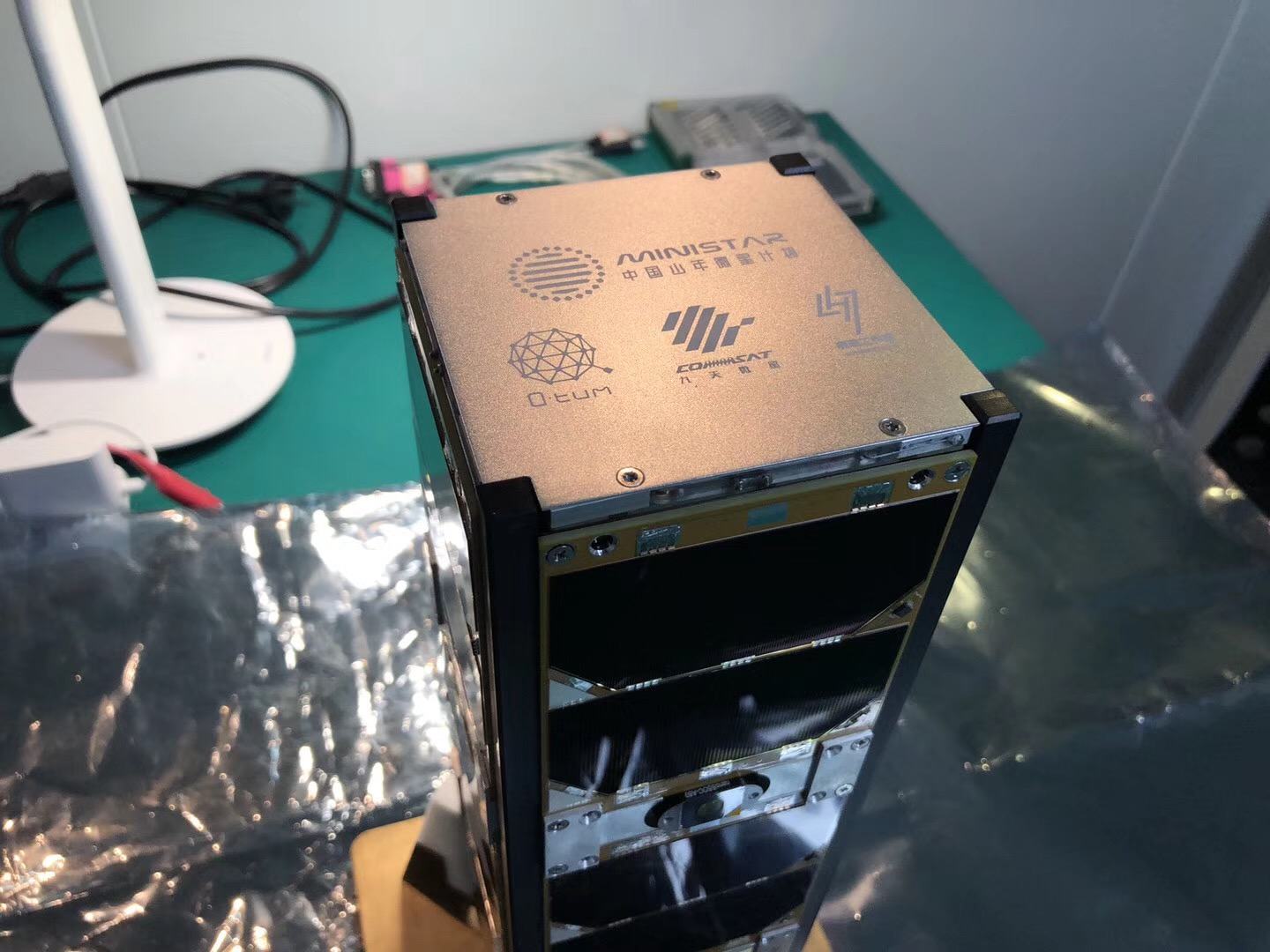
CubeSats deployed outside the International Space Station in May 2017. Photo credit: NASA.
From ecommerce to social networking to cloud computing, the lion’s share of internet services depends on a few, multibillion dollar corporates. Amazon, Facebook, Google, and others are emerging as the foundation of the internet industry.
For blockchain startups aspiring to create decentralized applications, this dominance poses a serious problem, believes Zheng Zuo, the 25-year-old CEO of Spacechain. Launched in April, the Singapore-based company wants to fire off its own satellites to create what Zheng thinks will become a truly decentralized ‘data distribution’ network.
“You can run a decentralized ecommerce platform, but in the backend, you’re using [Amazon Web Services],” he tells Tech in Asia during a trip to Beijing, adding that Facebook and Google are even laying down their own fiber optic cables. If blockchain companies reach a point where they threaten the profits of large players, it’s possible that they could shut down or be refused service.
“It’s their technology infrastructure,” he says. “After we all start depending on this centralized service, it’s hard to realize true decentralization.”
I think blockchain needs an ultimate backup [system].
Until recently, the satellite industry was mostly limited to government entities, contractors, and major commercial players. One key reason is cost. Big, geostationary satellites that orbit at altitudes of more than 35,000 kilometers above Earth can cost hundreds of millions of dollars to manufacture, maintain, and launch.
The emergence of smaller satellites at lower orbits has helped changed that. In particular, CubeSats – petite satellites about the size of a tissue box – have significantly lowered the barrier to entry, although it’s still no minor undertaking to start your own space venture. Developed by Stanford University and California Polytechnic State University, CubeSats have made it possible for university students to build their own orbiters. ArduSat, an Arduino-based twist on CubeSats, is even bringing the technology to high schoolers.

Spacechain’s satellite. Photo credit: Spacechain.
Startups are jumping into the aerospace industry as well. Both Elon Musk’s SpaceX and OneWeb are planning to launch their own constellation of low-orbit satellites to create a worldwide broadband network. Zheng thinks that space – the so-called final frontier – can play a role in the development of the blockchain industry.
“I think blockchain needs an alternative backup [system],” he explains. Spacechain plans to run a server on its own CubeSat, which developers will be able to use for their own software applications or data storage. “[Developers] can create backups for a lot of projects.”
“And it’s physically untouchable,” he adds with a grin.
Blockchain optional
If all goes as planned, Spacechain will launch its first CubeSat into space next February. The inaugural satellite will use the Qtum network, an Ethereum-like blockchain developed by one of Spacechain’s investors and partners, Qtum Foundation. The company’s CubeSat plans to run a Qtum node from space.
Among Spacechain’s eclectic roster of contributors and backers is Tim Draper, a billionaire bitcoin enthusiast. Draper is the founding partner of DFJ Venture Capital, a Silicon Valley firm whose portfolio includes SpaceX, Twitter, and cryptocurrency wallet Coinbase.
The most straightforward part of the project – building the satellite – is already finished, says Zheng. Spacechain is partnering with ComSat, a Chinese satellite service provider, to manufacture its CubeSat. GomSpace, a Danish nanosatellite manufacturing and design company, will be the supplier.
The challenge will be getting the software right. Spacechain wants to create an open-source satellite operating system where developers can build and run their own applications, like tracking shipping containers across the ocean or taking photos of Earth. The operating system will be “blockchain optional,” adds Zheng, and open to apps that aren’t blockchain-based.
For the mass majority of operators, data in space does you no good.
Those use cases aren’t new in and of themselves – GomSpace offers global tracking services precisely to meet those needs – but Spacechain argues that its operating system will make it possible for a wider range of applications to be developed by even more software engineers.
“Spacechain satellites add the capability to actually run applications in space,” says Jeff Garzik, the startup’s CTO, who is also a board member of The Linux Foundation and co-founder of Bloq, a US enterprise blockchain startup. “Traditional satellites are single-owner and single-application, simply rebroadcasting video and data from Earth.”
Storing data in space could also present developers with new possibilities. It’s certainly unconventional, says Jordi Puig-Suari, professor of aerospace engineering at California Polytechnic State University and co-inventor of CubeSat.
“We have heard of people interested in putting data in space as a kind of neutral territory where it is not on anyone’s backyard,” he shares. “It’s a very different thing from what most people do with satellites. For the mass majority of operators, data in space does you no good, so you want to send it down as quickly as possible. It’s a new way of looking at it.”

Left to right: CEO and CTO of Spacechain, Zheng Zuo and Jeff Garzik. Photo credit: Spacechain.
Science experiment
It’s still early days for Spacechain and its ambitions for the final frontier. The startup is not disclosing how much funding it has raised, but Zheng says that due to all the company’s research and development efforts, it’s currently dependent on private investors for funds.
In the future, Spacechain is considering a subscription-like model where developers pay for storage space on the satellite and certain functions of the operating system’s API. Creating a token economy with crypto-coins – tentatively dubbed SpaceCash – is another option, though that’s still a work in progress. Generating enough profit to cover satellite maintenance and operating costs will be daunting, but for now, it doesn’t seem to be a top concern.
Spacechain is not alone in its efforts to merge blockchain and satellite technology. Blockstream, a Canadian startup backed by LinkedIn co-founder Reid Hoffman, rolled out its own system in August.
There is no such thing as truly decentralized.
Unlike Spacechain, Blockstream is renting existing satellites, which are farther away from Earth and have more extensive coverage. One of its main goals is to make bitcoin more accessible in places where internet access may be unavailable or cost-prohibitive, explains Chris Cook, head of Blockstream’s Satellite team. According to his estimates, the hardware needed to receive data beamed down from Blockstream’s satellites amounts to about US$100.
Since going live, the startup’s Satellite program covers Africa, Europe, South America, and North America. By connecting to Blockstream’s satellites, users can download data from the bitcoin network and ensure their nodes stay in sync. The company is still working on two-way satellite communication – users can’t make transactions or mine at the moment – and expanding coverage to Asia-Pacific.
“We’re going to make it an open platform that anybody can send any arbitrary data via the satellite network, and just pretty much pay for the data that’s sent,” explains Cook.
“It could be used for anything, from a secure messaging channel to other blockchains that may want to run on it, including a private blockchain or another public ledger, or even some of our enterprise applications.”

Blockstream’s current satellite coverage.
To be sure, both Blockstream and Spacechain have a long roadmap ahead of them, and neither are guaranteed to succeed. Indeed, Spacechain will have plenty of costs to cover in managing its own fleet of satellites, especially since CubeSats are not meant to last for decades – some have to de-orbit within a year – and will need to be refreshed.
They also have a lot to prove to the blockchain community, whether it’s the security and reliability of their networks or how decentralized their systems really are.
“There is no such thing as truly decentralized,” says Gabriel Chan, fintech programs director of the Hong Kong Blockchain Society and architect of Dappler OS, an enterprise decentralized apps platform. “Spacechain, if successful, would be controlling the ground stations that communicate with its CubeSat blockchain network. That is actually less decentralized than if its blockchain network was terrestrially based, running through existing infrastructure.”
Finally, the final frontier isn’t a lawless, free space without boundaries. Successful launches still depend on regulatory approval and support from the country from which the satellite is ejected. “You still need to register somewhere to get frequencies to talk to the spacecraft – that would locate you in some place,” adds Puig-Suari.
Nevertheless, Zheng remains bullish on Spacechain’s satellite project, which he recognizes is experimental. As for regulatory approval, he is talking to partners around the world, especially in countries that are supportive of space ventures. China, for example, has agreed to be the site of Spacechain’s February launch.
“The Chinese government is interested in developing space and blockchain technology right now,” says Zheng. “We hope we can follow this momentum.”
This post The race to put blockchain in space appeared first on Tech in Asia.
from Tech in Asia https://www.techinasia.com/spacechain-blockstream-blockchain-to-satellite
via IFTTT
No comments:
Post a Comment